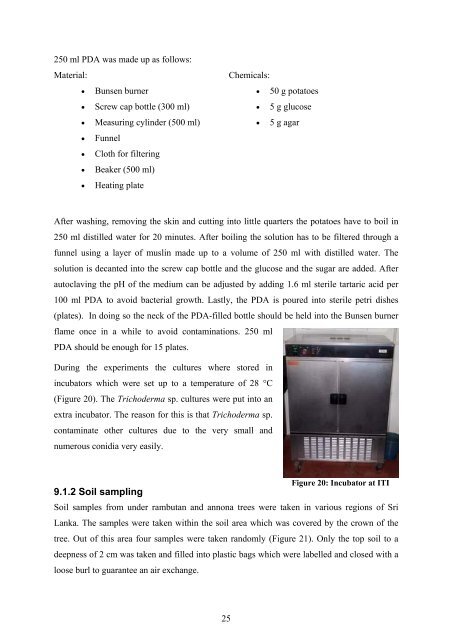Botryodiplodia sp. - Crops for the Future
Botryodiplodia sp. - Crops for the Future
Botryodiplodia sp. - Crops for the Future
You also want an ePaper? Increase the reach of your titles
YUMPU automatically turns print PDFs into web optimized ePapers that Google loves.
250 ml PDA was made up as follows:<br />
Material:<br />
• Bunsen burner<br />
• Screw cap bottle (300 ml)<br />
• Measuring cylinder (500 ml)<br />
• Funnel<br />
• Cloth <strong>for</strong> filtering<br />
• Beaker (500 ml)<br />
• Heating plate<br />
Chemicals:<br />
• 50 g potatoes<br />
• 5 g glucose<br />
• 5 g agar<br />
After washing, removing <strong>the</strong> skin and cutting into little quarters <strong>the</strong> potatoes have to boil in<br />
250 ml distilled water <strong>for</strong> 20 minutes. After boiling <strong>the</strong> solution has to be filtered through a<br />
funnel using a layer of muslin made up to a volume of 250 ml with distilled water. The<br />
solution is decanted into <strong>the</strong> screw cap bottle and <strong>the</strong> glucose and <strong>the</strong> sugar are added. After<br />
autoclaving <strong>the</strong> pH of <strong>the</strong> medium can be adjusted by adding 1.6 ml sterile tartaric acid per<br />
100 ml PDA to avoid bacterial growth. Lastly, <strong>the</strong> PDA is poured into sterile petri dishes<br />
(plates). In doing so <strong>the</strong> neck of <strong>the</strong> PDA-filled bottle should be held into <strong>the</strong> Bunsen burner<br />
flame once in a while to avoid contaminations. 250 ml<br />
PDA should be enough <strong>for</strong> 15 plates.<br />
During <strong>the</strong> experiments <strong>the</strong> cultures where stored in<br />
incubators which were set up to a temperature of 28 °C<br />
(Figure 20). The Trichoderma <strong>sp</strong>. cultures were put into an<br />
extra incubator. The reason <strong>for</strong> this is that Trichoderma <strong>sp</strong>.<br />
contaminate o<strong>the</strong>r cultures due to <strong>the</strong> very small and<br />
numerous conidia very easily.<br />
9.1.2 Soil sampling<br />
Figure 20: Incubator at ITI<br />
Soil samples from under rambutan and annona trees were taken in various regions of Sri<br />
Lanka. The samples were taken within <strong>the</strong> soil area which was covered by <strong>the</strong> crown of <strong>the</strong><br />
tree. Out of this area four samples were taken randomly (Figure 21). Only <strong>the</strong> top soil to a<br />
deepness of 2 cm was taken and filled into plastic bags which were labelled and closed with a<br />
loose burl to guarantee an air exchange.<br />
25

















